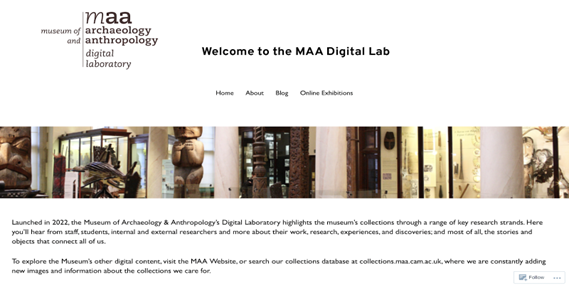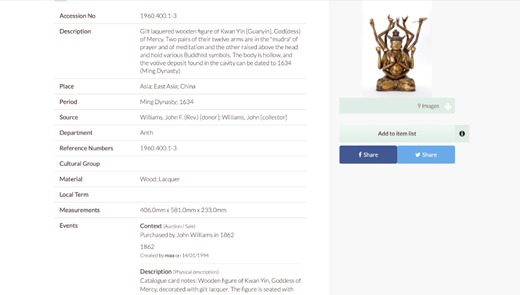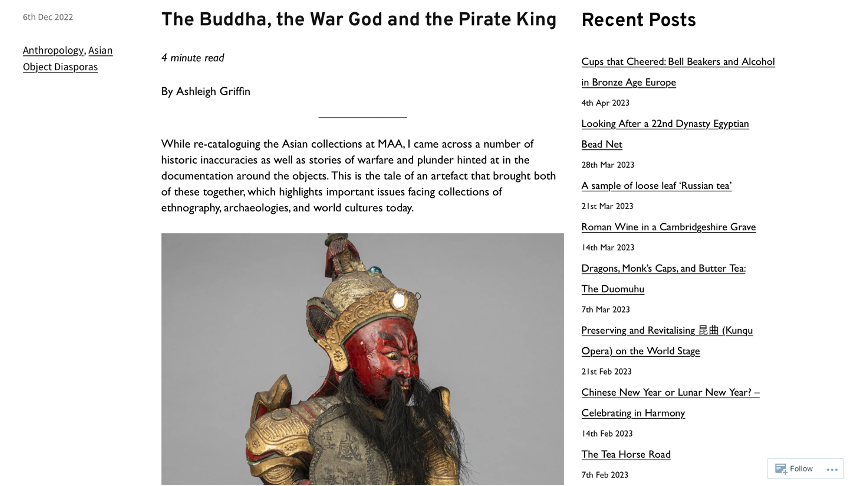
Credit to the author.
The origin of collections in the museum is deeply colonial. Since the 16th century, ‘exotic’ things were collected by European explorers who placed them in cabinets of curiosity (Amsel-Arieli 2012). Later, museums were created to gather and showcase those objects, creating an ‘expression of the Western conviction in the onward march of the rational’ (MacKenzie 2017). Today, as a result of such a legacy, many objects in museums have been parts of collections through the colonial process. Therefore, to further advance the trajectory of decolonisation, understanding the colonial past of museum collections is an integral part of the effort. Objects situated as the trophies of colonialism, become a means for us to unpack the process in reverse. Methodologically, how can we utilise museum objects as a tool of decolonisation? The recent launch of the digital lab at Cambridge University Museum of Archeology and Anthropology (MAA) offers an insight into such a possibility. In the digital lab, museum objects are carefully catalogued and analysed to reach a wider audience while revealing their colonial history. By reflecting upon the MAA Digital Lab, I try to comment on the possibility of focusing on objects as a method for decolonising museums. I argue that object study helps us to understand the context of how collections have travelled, and in some cases been misidentified within the colonial context. By adding an object’s historical context back into its story, the dichotomy between provenance and collection is broken down, thus enriching our knowledge of both objects themselves and missing details from their colonial history.
What is MAA Digital Lab?

The MAA Digital Lab was launched in late 2022 as an online platform aiming to create public digital engagement and access to its collections. It has a particular focus on the ‘transparency regarding legacies of colonialism, pushing towards greater dialogue, equality and change in our thought and practice, and diversifying the narratives and voices that speak to and about the collections’ (Elliott 2022). By doing so, the Digital Lab offers an extensive object catalogue of museum collections, a constantly updated section of blog posts, research notes, and online exhibitions. Furthermore, university staff, students, and external researchers are all openly invited to contribute to the blog-making. They are invited to start with an object from the museum catalogue and discuss the history of how those objects have connected to their source communities and how they arrived at the MAA. Currently, the blog posts are arranged according to two themes: 1) Object Diasporas that trace ‘the journeys by which artefacts have reached Cambridge, from complex local trajectories of production and use to the power relationships of colonial era collecting’, and 2) Substances of Wellbeing and Intoxication, objects related to drinks and other substances in “the social and cultural contexts in which they were consumed, the journeys they took and the interpretations offered by collectors and curators” (Elliott 2022). In short, the MAA Digital Lab is a comprehensive tool and source of knowledge, with detailed information about museum objects, and a place for constantly updated blog posts to reveal the travels and histories of objects in its collection.
What makes the MAA Digital Lab distinctive, and how does it help us with decolonisation? First, the Digital Lab offers a rich catalogue of objects collected in museums. In the catalogue, the introduction does not only explain the provenance and visual appearance of each object but also provides a detailed context of how they have been treated before and after becoming a museum collection. For an instance, my current research focuses on the Tibetan Buddhist statues collected in MAA. When I look into an object in its digital archive, the context section provides a detailed description of how an object has travelled, been used, and physically changed across different periods. Taking an example, a Gilt lacquered wooden figure of Guanyin (MAA 1960.400.1-3) gives information about how its donor, John F. William, acquired the statue from the purchase of his grandfather, and how the votive deposit was removed before arriving. The votive offerings of the statue were taken out by Williams and are now separately collected by the MAA. By searching the descriptions from catalogues, we can add a new dimension to an object’s history not only through its physical appearance but also through the story both before and after it was placed in the museum.

Moreover, the blog post and research note section also invite researchers to discover stories of colonial history by highlighting the diaspora of objects through their past misinterpretation and attribution. For example, one of the blog entries focuses on the figure of Guanyu, a warrior and a Taoist deity made in a southern Chinese Taoist temple during the early 19th century (Griffin 2022). The statue was presented to the Fitzwilliam Museum by Isaac Bernard, a British Captain serving a company involved in the Opium trade during the 1850s. The blog highlights the past misattribution of the statue from its British donor and the possibility of a renewed providence emerging from the context of the Opium War. Opium was valued as a medicine in China and British traders would exchange it for tea. However, opium became an addictive drug to millions of people in the country and China’s effort to end the opium trade sparked military conflicts with Britain, ending the war with two treaties ceding Hong Kong, giving more privileges to British traders, and forcing China to pay reparations (Griffin 2022). During such a historic period, this statue was brought to Cambridge. It was first considered by the donor as a “Pirate King and his Wife” when it was initially brought into the Fitzwilliam Museum, while another note on the statue misidentified the statue as a “Buddha” when it was transferred to the MAA (Griffin 2022). The blog posts, as the discussion of the Guanyu statue exemplifies, offer a discussion of how museum objects were interpreted in different ways under different ownerships. By looking at the process of interpretation, we can gain an insight into how an object was misinterpreted during the past, thus informing the colonial history each object has embodied. In summary, both the object catalogue and blog post sections from the MAA Digital Lab provide details of objects beyond their appearance by exploring contexts between provenance and museum collection. By looking at those contexts of objects as a research method, we can understand the colonial process of which an object may have been through.
MAA Digital Lab and Decolonisation in Object Research
Reflecting on the MAA Digital Lab, it offers a dialogue in the ethnographic approach of making an object’s biography. Through anthropological inquiry, an object is considered to have a social life, as it moves through different contexts of exchange, and acquires different identities and values (Appadurai 1986). To map an object’s social life, Kopytoff (1986) argues for the making of an object biography by highlighting the changes in its cultural value. Furthermore, Drazin (2020) also advocates for the use of object biography as an ethnographic method: we choose one object to follow and describe its changes, direction of travel, and finally create a biography that helps us ‘raise the critical perspective and alternative frameworks for understanding culture’ (63). Lastly, applying object biography to the museum, Alberti argues for objects as a relational site of the museum. As Alberti (2005) describes, the value and significance of things are imbued by people, and the life of an object in a museum reflects its contemporary social relationships through attributions of different meanings (561). Therefore, Alberti (2005) suggests that objects gather meanings ‘through associations with people they encountered on their way to the collection, thus linking the history of museums to broader scientific and civic cultures’ (559).
Linking object biography as an anthropological method to the MAA Digital Lab, we can see how the Digital Lab allows us to engage with objects and their social relations through both digital catalogue and blog-making. On the one hand, the digital catalogue provides detailed descriptions of the source of an object and the context to which it may have been attributed, physically changed, or identified. On the other hand, those detailed descriptions then provide a resource for researchers to trace an object’s biography and learn about the processes of how they were possibly misattributed as a part of colonial history. The use of the Digital Lab thus echoes Drazin’s (2020) suggestion, where object biography enables us to raise such a ‘critical perspective’ in understanding culture by exploring the changes and contexts of an object’s colonial history. Moreover, resonating the Digital Lab with Alberti (2005), objects become a site where their colonial meanings were gathered through past social relations. By studying those relations, the history of the museum in broader topics such as the history of colonialism is discussed. Therefore, I suggest the Digital Lab integrates the decolonisation process by focusing on an object’s social life as a site of research in and of itself. By looking at past misattributions, identities and interpretations of objects, the Digital Lab can fill in the knowledge gap between an object’s origin and its placement in the museum. Those highlight how research into object biography may thus shed new light on colonial history, revealing contexts once made invisible by the forces of colonialism.
Finally, as the MAA Digital Lab highlights the biographical context of an object, it provides an opportunity to discuss aspects which other museums may have overlooked. In many museums, objects are recorded with a description of their visual analysis and a brief information of their origin (in many museums, object databases only record each collection’s visual and physical aspects and the place of origin, accompanied by a legal note. A close example can be seen is the Fitzwilliam Museum database: https://www.fitzmuseum.cam.ac.uk/objects-and-artworks). However, the context of how objects have travelled and been misidentified in the process of becoming a part of the museum is often easily ignored. The in-between moment from origin to collection, as the MAA Digital Lab has demonstrated, becomes an important space to understand the colonial background of museum objects more broadly. Therefore, I suggest to further advance the decolonisation effort, we should take each object’s social life seriously. By breaking down the black box between provenance and collection, the MAA Digital Lab offers an opportunity for a research method where an object’s colonial history can be rediscovered and readdressed. Lastly, object study becomes a method of decolonisation by breaking down the duality between a museum’s provenance and collection. By paying attention to those liminal moments between origin and accession, the often overlooked details of an object’s colonial history come to life.
Xintian Ma is from Guizhou province in Southwestern China. He is currently a MPhil student in Social Anthropological Research at the University of Cambridge. He recently graduated from the University of St Andrews with an undergraduate degree in International Relations and Social Anthropology. With research interests in politics, heritage, museums, religion and ethnicity, his MPhil dissertation focuses on the social life of Tibetan Buddhist statues collected in Cambridge University Museum of Archaeology and Anthropology.
Bibliography
Alberti, S. J. M. M. 2005. Objects and the Museum. Isis, 96(4), 559–571.
Amsel-Arieli, M. 2012. “Cabinets of Curiosity (wunderkammers)”, History Magazine, 13, 40-2.
Appadurai, A. 1986. “Toward an Anthropology of Thing”, in The Social Life of Things: Commodities in Cultural Perspective. Cambridge: Cambridge University Press. 1-2
Drazin, A. 2020. “The Object Biography”, in Lineages and advancements in material culture studies. Routledge. 61-74.
Elliott, M. 2022. “Introducing MAA’s Digital Lab”, MAA Digital Lab. https://maadigitallab.org/2022/12/06/introducing-maas-digital-lab/
Kopytoff, I. 1986. “The Cultural Biography of Things: Commoditization as Process”, in The Social Life of Things: Commodities in Cultural Perspective. Arjun Appadurai, ed. Cambridge: Cambridge University Press. 64-92.
MAA. 2023. “Welcome to the MAA Digital Lab”, MAA Digital Lab. https://maadigitallab.org/about/
MAA. 2023. 1960.400.1-3: “Gilt lacquered wooden figure of Kwan Yin [Guanyin], God(dess) of Mercy”. https://collections.maa.cam.ac.uk/objects/494491
MacKenzie, J. M. 2017. “Introduction”, in Museums and Empire. Manchester, England: Manchester University Press.
Griffin, A. 2022. “The Buddha, the War God and the Pirate King”, MAA Digital Lab. https://maadigitallab.org/2022/12/06/the-buddha-the-war-god-and-the-pirate-king/
